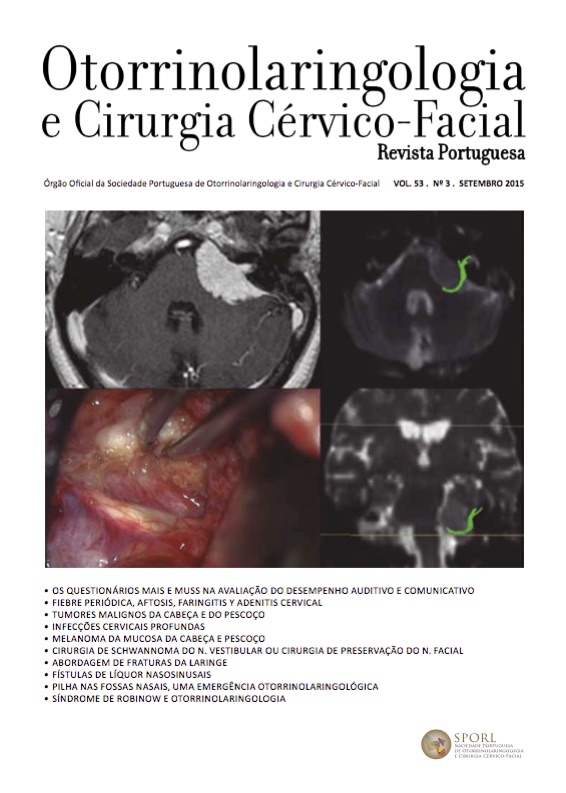Vestibular Schwannoma surgery or facial nerve preservation surgery?
DOI:
https://doi.org/10.34631/sporl.596Keywords:
Vestibular Schwannoma, Facial Nerve, Facial Nerve TractographyAbstract
The authors review the evolution of the surgical strategy regarding vestibular nerve schwannomas. The classic neurosurgical goal aims to remove the tumor completely. Presently, we believe this approach has changed significantly. Both the preservation of the facial nerve and tumor resection are the main objectives of the surgery. In this review, we place a special emphasis to the management of large tumors (grade 3 and 4 of Koos Scale) and the quality of life of patients after the surgery.
We describe an innovative imaging technique used in Portugal, which is performed at the Lusíadas Hospital, in Lisbon. All the patients treated at the Skull Base and Neurorhinology Department of the Hospital de Egas Moniz (Lisbon) are pre-surgically evaluated by MRI and Diffusion Tensor Imaging. Diffusion Tensor Imaging allows to determine the location of the facial nerve by means of Tractography. Cranial nerve Tractography contribute to successful skull base otoneurosurgeries, particularly by lowering the risk of nerve injury during cerebellopontine angle surgeries and reducing the time spent to locate fiber bundles intra-operatively.
Downloads
References
Koos WT, Spetzler RF, Bock FW, Salah S. Microsurgery of cerebellopontine angle tumors. In: Koos WT, Spetzler RF, Bock FW, eds. Clinical Microsurgery. Stuttgart, Germany: Georg Thieme;
:pp91-112.
Gurgel RK, Dogru S, Amdur RL, Monfared A. Facial nerve outcomes after surgery for large vestibular schwannomas: do surgical approach and extend of resection matter ? Neurosurg Focus. 2012;33(3):E16.
House JW, Brackmann DE. Facial nerve grading system. Otolaryngol Head Neck Surg. 1985;93:146-147.
Copeland WR, Hoover JM, Morris JM, Driscoll CL et al. Use of preoperative MRI to predict vestibular schwannoma intraoperative consistency and facial nerve outcome. J Neurol Surg B Skull Base. 2013;74(6):347-350.
Moffat DA, Parker RA, Hardy DG, Macfarlane R. Factors affecting final facial nerve outcome following vestibular schwannoma surgery. J Laryngol Otol. 2014;31:1-10.
Zhang Y, Chen Y, Zou Y, Zhang W et al. Facial nerve preservation with preoperative identification and intraoperative monitoring in large vestibular schwannoma surgery. Acta Neurochir (Wien). 2013;155(10):1857-1862.
Sameshima T, Morita A, Tanikawa R, Fukushima T et al. Evaluation of Variation in the Course of the Facial Nerve, Nerve Adhesion to Tumors, and Postoperative Facial Palsy in Acoustic Neuroma. Journal Neurolog Surg. 2012;B74:39-43.
Gerganov VM, Klinge PM, Nouri M, Stieglitz L et al. Prognostic clinical and radiological parameters for immediate facial nerve function following vestibular schwannoma surgery. Acta Neurochir (Wien). 2009;151(6):581-7.
Taoka T et al. Displacement of the Facial Nerve Course by Vestibular Schwannoma: Preoperative Visualization Using Diffusion Tensor Tractography. J Magn Reson Imaging. 2006;24:1005-1010.
Pereira PM, D’Almeida G, Escada P, Taoka T et al. Tractography of the facial nerve in tumors of the cerebellopontine angle. Proceedings of the American Society of Neuroradiology-50th Annual Meeting. 2012; p-25:405-406.
D’Almeida GN, Escada P, Marques L, Pereira PM et al. Surgical proven location of vestibular schwannomas depicted preoperatively by tractography. Journal of Neurological Surgery Part B. 2012; 73(Sz02):A269.
Escada PA, Pereira PM, D’Almeida GN, Taoka T et al. Diffusion Tensor Tractography of the facial nerve. Otolaryngology, Head and Neck Surgery. 2012; 147:P205.
Nonaka Y, Fukushima T, Watanabe K, Friedman A et al. Contemporary Surgical Management of Vestibular Schwannomas: Analysis of Complications and Lessons Learned Over the Past Decade. Neurosurgery. 2013;72(ONS Suppl):ons103-115.
Mulder JJ, Kaanders JH, van Overbeeke JJ, Cremers CW. Radiation therapy for vestibular schwannomas. Curr Opin Otolaryngol Head Neck Surg. 2012;20(5):367-71.
Rasmussen R, Claesson M, Stangerup SE, Roed H. Fractionated stereotactic radiotherapy of vestibular schwannomas accelerates hearing loss. Int J Radiat Oncol Biol Phys. 2012;83(5):e607-11.
Kondziolka D, Lunsford LD, McLaughlin MR, et al. Long-term outcomes after radiosurgery for acoustic neuromas. New Engl J Med. 1998;339:1426-1433.
Cheng S, Naidoo Y, da Cruz M, Dexter M. Quality of life in postoperative vestibular schwannoma patients. Laryngoscope. 2009;119(11):2252-2257.
Alfonso C, Lassaletta L, Sarriá J, Gavilán J. Quality of Life Following Vestibular Schwannoma Surgery. Acta Otorrinolaringol Esp. 2007;58(2):61-65.
Witgert ME, Veramonti T, Hanna E. Instruments for Estimation of Health-Related Quality of Life in Patients with Skull Base Neoplasms. Skull Base. 2010;20(1):5-10.






